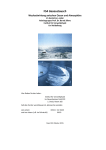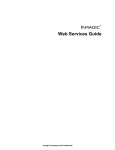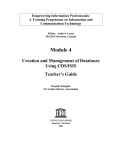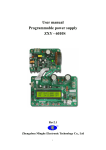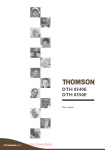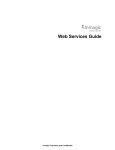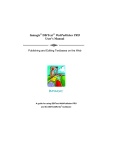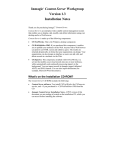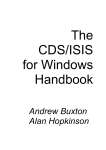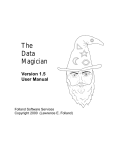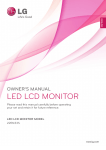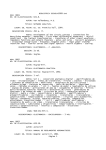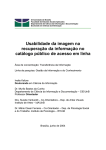Download - QUT ePrints
Transcript
Evaluation of UNESCO’s CDS/ISIS and some Inmagic text storage and retrieval products CAO MINH KIEM and MICHAEL MIDDLETON Preprint of paper published in Program (1998), 32(3), 283-302. [ISSN: 0033-0337] ABSTRACT A comparison was made between CDS/ISIS, its Windows version WINISIS, and Inmagic’s INMAGIC and DB/TextWorks software. Packages were evaluated for their database creation, information retrieval and report production capabilities. Windows versions were found to provide significant enhancements over DOS versions of software. 1. Introduction 1.1 Software categories A great deal of personal computer software is now available for organisation of information. Such information management systems usually comprise structured database and information retrieval components. A number of writers have advanced categories for such software. For example Burton and Petrie1 differentiate between conventional database management systems and information retrieval systems. McCarthy2 distinguishes between file management systems, database management systems, preconfigurated data management systems, and text-oriented data management packages. Sieverts and Hofstede3 suggest grouping into classical retrieval systems, end-user software, and ‘other’ (indexing, full-text retrieval, hypertextual, personal information management, and best match and ranking programs). The classical retrieval systems resemble those developed for on-line information retrieval systems. Saffady4 uses the term “text storage and retrieval systems” for full text retrieval systems - software products that operate on the complete content of a document. We use the term textual storage and retrieval systems to indicate the group of products belonging to the classical category in the Sieverts and Hofstede classification. Management of structured text can be seen as a specific application that requires software used for this purpose to have special features. Structured textual data (for example, bibliographic descriptions) have characteristics such as variable length fields and records and multiple values for fields, that make them difficult to Cao/Middleton Page 1 manage with generic database systems such as Access, DBase, and Oracle with their orientation towards numerical, fixed-length field data. Features and capacity of text storage and retrieval systems vary markedly. Selection of the most appropriate software package for a particular environment is challenging. 1.2 CDS/ISIS and Inmagic Here we consider two Inmagic Inc. products, INMAGIC PLUS 1.0 and DB/TextWorks 1.0 together with UNESCO’s CDS/ISIS and WINISIS. Versions of these packages have been described favourably in a variety of contexts. The DOS version of CDS/ISIS is a well-known textual information storage and retrieval package in the developing countries. Kumar and Kar5 reviewed the worldwide application of CDS/ISIS, and showed that the use of CDS/ISIS is an inexpensive approach to library computerisation. Sieverts et al6 when comparing it with other 8 programs including INMAGIC 7.2 concluded that despite some deficiencies, “CDS/ISIS is a very powerful and versatile program”. Mahmood7 considered it the best library software for developing countries. Over the last nine years it has become one of the most popular packages of its kind in the world. Over 15,000 registered copies of the software have been distributed free-of-charge (or at cost price), in both developed and developing countries8. INMAGIC PLUS is among the best-selling library software in the United States and a number of other countries. Cibbarelli9 reported about 30,000 Inmagic installations in 55 countries in 1995. It is a popular library software in law firms, universities, Government agencies and other business building text-based retrieval systems10. Inmagic DB/TextWorks, a software package for Windows-based PCs and networks, was introduced in 199511. It includes “relational-like” database linking, integrated image management and other features. Costs depend upon type of implementation, and range form US$795 for single user, US$2900 for 5 user, US$4500 for 10 user and up12. 1.3 Purpose of evaluation The evaluation was carried out in order to determine the advantages to a developing country of creating bibliographic databases using commercial software, and the extent to which these advantages were offset by the cost of such software. It had the secondary purpose of comparing the utility of the packages for illustration of Cao/Middleton Page 2 information storage and retrieval principles in an instructional information management environment. The particular packages were examined because of their significant local use in the business environment (in the case of INMAGIC products) and educational environment (in the case of CDS/ISIS), and because of implementations of CDS/ISIS in a number of countries in the South-East Asian region. 2. Overview of the software CDS/ISIS Micro CDS/ISIS was based on the Mainframe version of CDS/ISIS, started in the late 1960s, thus taking advantage of the several years of experience acquired in its development13. It may be regarded as a classical information retrieval system. Table 1 itemises some of its key features. • Handling of variable length records, fields and subfields • User-defined database with different data type to be processed for a particular application • Entering and modifying data through user-created database specific worksheets • Retrieval with Boolean and proximity search operators as well as free-text searching; • Sorting and report generating facility for directories, catalogues, indexes, etc. • Data interchange function based on the ISO 2709 • CDS/ISIS PASCAL integrated application development programming language allowing users to tailor the system to specific needs; • Functions that allow users to build pseudo-relational data bases. • Multilingual package with tools for local linguistic versions • Utilities that allow users to create system and used-defined menus and/or worksheets Table 1: CDS/ISIS Features UNESCO distributes English, French and Spanish versions of the package and has helped in developing versions for Arabic, Chinese and Korean. The first version 1.0 was released in December 1985. It is designed to run on IBM PC/XT with minimal (256K) RAM and hard disk requirements. It comprised 6 different programs to execute the various functions. Databases were able to handle up to 32,000 records. Cao/Middleton Page 3 In 1989, version 2.3 was distributed, integrating all programs into one14. The database capacity was extended to 16,000,000 records, and the PASCAL programming language interface was introduced. Release 3.0, which supports local area networks, followed in 1992. The latest MSDOS version 3.07 was distributed in 1994. The Beta test version 1.0 for Windows, WINISIS, was launched in 1996. The version we consider is the June 1997 version. Functions are carried out by a set of 8 major services grouped into two categories: user services and system services. The four user services are: • ISISENT Data entry and record editing. • ISISRET Information retrieval. • ISISPRT Printing and sorting. • ISISINV Inverted file maintenance. The four system services are: • ISISDEF Database definition or modification. • ISISXCH Data exchange facilities and master file maintenance. • ISISUTL Utilities. • ISISPAS Advanced programming facility. A database consists of logically related but physically distinct computer files. File names are listed in Table 2. In the table, xxxxxx represents the name of the database, and yyyyyy represents user-chosen file name. A database definition consists of four mandatory components each stored in separate files: Field definition table (.FDT), Data entry Worksheets (.FMT), Display/Print formats (.PFT), and Field Select Table (.FST). The Inverted file is an index file of the master file (which contains all database records). There is only one inverted file (.IFP) for one given database. It contains all terms that are used as access points during the retrieval for a given database. Information on how terms are selected to be included in the file is defined by FST. The ANY file (.ANY) is an optional file that is associated with the inverted file. It defines ‘any’ terms, each of which is a collective name assigned to a group of search terms. CDS/ISIS will automatically use all terms that are assigned in the given ‘any’ Cao/Middleton Page 4 term to form a search operation. For example we can create ‘ANY Southeast-Asia’ which defines the name of all countries in the region (Indonesia, Malaysia, Thailand…) File name Notes / Functions xxxxxx.FDT Field Definition Table (FDT); defines the fields and their characteristics. pxxxxx.FMT Data Entry Worksheets (FMT); define the screen layout used to create records of a database. pyyyyy.FMT xxxxxx.PFT Display/Print Formats; define the screen display and print layout of records. yyyyyy.PFT yyyyyy.FST Field Select Table (FST); he first FST (with database name) defines fields to be indexed and indexing techniques for them; additional FSTs are used for data exchange. xxxxxx.MST Master File; a data file which contains all records of a given database xxxxxx.XRF Cross-reference File; gives the location of each record in the Master File; must be copied with the master file. xxxxxx.CNT B*tree (search term dictionary) control file xxxxxx.N01 B*tree nodes (for terms up to 10 characters long) xxxxxx.L01 B*tree Leaf (for terms up to 10 characters long) xxxxxx.N02 B*tree nodes (for terms longer than 10 characters) xxxxxx.IFP Inverted file posting xxxxxx.ANY Any file xxxxxx.STW Stopwords file xxxxxx.FST Table 2: CDS/ISIS Database Files The two basic components of CDS/ISIS are its menu system and worksheets (System and Data entry). Menu modification is undertaken using the System Utilities Services. System Worksheets are used for stipulating parameters that are needed to execute a given function, e.g. printing, data exchange. They are predefined but may be redefined. Data entry worksheets are used to create or modify a database record. The Windows version of CDS/ISIS is being developed. The June 1997 Beta release may be downloaded from UNESCO’s Internet site. This version includes: • Data Entry module (using existing worksheet files). • Print and sort modules (using existing formats). • A Guided Search Interface (OPAC). • A more complete On-line-Help File. • ISIS-DOS indentation commands. • Internationalisation (English and Italian messages are provided). Cao/Middleton Page 5 Policy for CDS/ISIS development includes: • Rewriting in C programming language in order to provide a common standardised language for all the versions (MSDOS, WINDOWS, UNIX, VAX/VMS). • Adopting a multi-platform software development system in order to increase portability. • Implementation of client-server architecture. A network of some 135 officially appointed distributors around the world is established. The conditions on use of CDS/ISIS are specified in the Licence Agreement signed between UNESCO (or the official distributor) and the receiving institution. 2.2. INMAGIC INMAGIC is a software package developed by the Inmagic Inc.®. It includes necessary tools to perform database definition and maintenance, information retrieval, and report production. The first version was introduced in 1980 and was written in the FORTRAN language15. In 1984, INMAGIC was rewritten in C and upgraded for microcomputers16. In 1989, SearchMAGIC, a search-only end user interface, was released, allowing the users to distribute INMAGIC databases to the others. In 1992, SearchMAGIC was combined with INMAGIC 7.2 and released as INMAGIC PLUS, including capacity for image management17. It is not an Optical Character Recognition, package but images can be stored, displayed and printed. The company also produces INMAGIC PLUS for Libraries and INMAGIC PLUS for Law Firms, incorporating predefined database definitions and report formats. Like a CDS/ISIS database, an INMAGIC database consists of records that contain a collection of fields. File types used are listed in Table 2, where xxxxxx represents database name. The .DIC and .DTM files must be synchronised with the .DAT to avoid database errors. The data structure file .STR must be created prior to database creation. Users communicate with the INMAGIC through a menu hierarchy. File name Cao/Middleton Notes Page 6 xxxxxx.STR Data structure; more than one database may use a structure. xxxxxx.DAT Records and their indexes. xxxxxx.DIC Directory of the records within the .DAT file; if the .DIC file is lost, the record in the database cannot be retrieved. xxxxxx.DTM List of database changes made but not yet indexed.; must be copied when .DAT is. xxxxxx.DQM Quick index of records within .DTM; must be copied when .DAT is. xxxxxx.FMO Report definition file. xxxxxx.FMS Report format definition form; written out to a file for printing or editing. xxxxxx.SMU Set of search prompts and a record display format available for use with a database. xxxxxx.SRy User work file; provides a place for INMAGIC to store searches, as well as workspace for sorts; last character ‘y’ is a work file ID code. Table 3 : INMAGIC Files DB/TextWorks, which is a software package for Windows-based PCs and networks, was introduced in 1995. Inmagic, Inc. refers to DB/TextWorks as textbase software with integrated image management for Windows18. It has much in common with the INMAGIC PLUS, but with new features such as: • Relational-like linking, enabling common data in one textbase to be referenced by other data. • Drag and drop WYSIWYG report writer design. • Report printing fully enabled with Windows fonts. • Image management capabilities supporting many standard file formats, including TIFF, JPEG, and BMP. • Customising user interaction with databases with menu screen designer. • Search indexes may be produced for all fields and 250 fields are permitted per database. • More field types including text, numbers, date, are permitted. • Internet publishing is facilitated by the use of the HTML Write-to-file feature to publish reports created in DB/TextWorks. When a textbase is created, DB/TextWorks generates a number of files, each of which has the same name as the textbase, but a different extension as in Table 4. Extension TBA ACF DBS IXL DBR DBO SDO BTX Cao/Middleton Description . Primary textbase definition file, also contains elements stored in the textbase. Access control file, controls simultaneous access by multiple users. Textbase structure file, contains field definitions. Indexed list file, contains the validation and substitution lists. Contains the records (including deferred new, deleted, or changed records). Contains a directory to the records in the .DBR file. Contains a directory to records with deferred updates in the .DBR file. Contains the Term and Word indexes for the fields. Page 7 OCC LOG HLP INI Contains the lists of records indexed by the terms and words in the .BTX file. Textbase log file, lists changes to the textbase structure and records. Optional textbase-specific Help file. Optional file used with the Copy Special feature. Table 4: Textbase files 3. DOS Software Evaluation 3.1 Criteria Several approaches have been taken to evaluation of information management systems. Some focus upon analysis of information retrieval features of the search interface19, 20 and include search functions, user assistance and output flexibility. Others look more broadly at the software packages in their environment and include criteria such as input and maintenance of data, indexing of stored information, interactive searching, output features, use of the program, special versions and security, and technical requirements of software3, 21. We have used also used this broader approach. However, since the evaluation was carried about using small test bibliographic databases of about 50 records on the subject of information policy, our emphasis is on a features analysis of input, output and information retrieval facilities. 3.2 Comparison We evaluated CDS/ISIS 3.07 and INMAGIC PLUS 1.0. Minimal RAM for CDS/ISIS is 640 Kb and for INMAGIC is 500 Kb. Hard disk space per program is 2 Mb and 1.5 Mb respectively. System limitations INMAGIC has no limitation on the record and field length, enabling storage of complete structured large documents. CDS/ISIS allows all fields to be indexed. The 200 lines of FST indicates that all fields can be indexed - each line in the may have more than one field. Limitations are summarised in Table 5. Characteristics Maximum number of databases Cao/Middleton CDS/ISIS 3.07 unlimited Page 8 INMAGIC PLUS unlimited Maximum number of records/database 16,000,000 unlimited 8,000 characters unlimited 200 75 8,000 characters unlimited Maximum number of indexed fields 200 lines 50 Fields per data entry worksheet page 19 fields not applied Maximum number of pages/worksheet 20 pages not applied 4,000 not applied Maximum number of stopwords 799 words Total length of stopword list including space <= 255 Maximum length of indexed term 35 characters 59 characters Characters per record Fields per record Characters per field Maximum size of a display formats Table 5: System limitations An INMAGIC database has one default data entry worksheet, while a CDS/ISIS database may have many. Each CDS/ISIS data entry worksheet may have several different pages. Database definition For CDS/ISIS, definition involves four steps: • Creating Field Definition Table. • Creating data entry worksheet. • Creating Field Select Table. • Writing a display or print format. CDS/ISIS does not automatically create default data entry worksheet based on the existing FDT. INMAGIC will automatically create a default data entry worksheet and display format provided that the user has created a structure. Part of an example is shown in Figure 1. Type F/1 F/2 F/3 F/4 F/5 F/6 F/7 F/8 F/9 F/10 F/11 F/12 F/13 Cao/Middleton LABEL ID TI TO AU CO JO SO SE URL CF PY PD VOL NAME RECID TITLE TIT_ORIG AUTHOR CORPORATE JOURNAL SOURCE SERIES INTERNET CONFERENCE PUB_YEAR PUB_DATE VOLUME INDEX Y Y N Y Y T T T T T T N N Page 9 SORT 2 5 EMPHASIS for each field 1 1 5 5 5 2 5 5 5 1 1 1 1 1 1 1 1 1 F/14 F/15 F/16 F/17 F/18 F/19 NO PG LA DT AB DE NUMBER PAGE LANGUAGE DOC_TYPE ABSTRACT DESCRIPTOR N N Y T K Y 5 1 1 5 1 1 1 1 Figure 1: Example INMAGIC data structure When there is a need for data structure modification, CDS/ISIS allows addition of fields anywhere in the FDT. With INMAGIC, once you have saved the data structure you cannot rearrange field order nor can you add fields except at the end of the structure. In CDS/ISIS, you may also delete fields without losing your data. They remain in the master file. Updates Although CDS/ISIS checks consistency of other database structure files with the changes made to FDT, it informs you of the need for modification which you must then carry out yourself. If you change indexing code or order key in an INMAGIC data structure you need to use the Build or Remove options on all databases using that structure. In the case of CDS/ISIS, in order for changes made to FST to have effect on the whole inverted file, you also need to regenerate the file. Copying data structure files INMAGIC allows many databases to share the same data structure file. A new data file may be generated using the existing data structure. In the case of CDS/ISIS, each database must have its own FDT, even when it is identical with other structures. There is no facility for direct copying the existing database definition files within the CDS/ISIS, except through DOS. CDS/ISIS, however, allows the users to create different customised data entry worksheets for databases, each of which may contain different fields, whereas INMAGIC has only one default data entry worksheet which is created automatically by the system.. CDS/ISIS also allows copying from existing FST and print formats. Creating auxiliary files Auxiliary files include files for stopwords, the ‘any’ file, validation, and search prompts. INMAGIC has 14 default stopwords to which additions may be made. INMAGIC has a standard option for creating validation files and search prompts. A validation file is not used by standard CDS/ISIS and the stopwords file and ‘any’ file must be created by text editor programs. Security Cao/Middleton Page 10 CDS/ISIS can exercise the use of password and security to some extent. It does not provide user internal facility to define passwords to restrict access to certain functions or files. However, SYSPAR.PAR can be used to create “passwords” that redirect users to particular menus, worksheets, or display formats that hide certain functions or fields. INMAGIC allows users to control master password for system manager and passwords for users with access to certain fields. Data maintenance Table 6 summarises the comparison of data input features. Both packages have provision for batch input - ASCII files in the case of INMAGIC, ISO2709 format in the case of CDS/ISIS. Because CDS/ISIS is developed in relation to the standard, it is able to make use of the delimiters and subfield elements that are embodied in its structure. It can therefore accommodate implementations of ISO2709 such as MARC and the CCF. Characteristics CDS/ISIS INMAGIC yes yes built-in built-in Editing and deleting existing records yes yes Acceptance of data in extended of 8-bit ASCII code yes yes Data to be entered in a record structure with separate fields yes yes Availability of predefined record structures yes yes Creating a permanent default settings template yes yes Creating temporary default setting template yes yes Field contents to be checked for type of data or against authorised list no yes Compulsory input option for certain fields yes yes Direct input from other sources without conversion no no Global editing of information in specified fields or common information no yes ISO 2709 from a text file Direct input from keyboard Screen editor included or separate word processor Flexibility of batch input format Table 6: Data input and maintenance In a CDS/ISIS database, you can delete fields without causing damage to existing master files before you do reorganisation of the master file or export into an ISO 2709 file, but you cannot edit data in the deleted fields. CDS/ISIS also allows you to change field attitude (length, pattern, type) without damaging an existing database, though if you shorten fields you cannot then edit records containing longer fields without restoration of the original length. This problem is not present with INMAGIC because it does not have field length limit or definition. INMAGIC does not provide internal backup facilities. It uses DOS BACKUP and RESTORE. CDS/ISIS, however, has its own backup and restore utilities. These work only on the master file. The database structure file must be copied separately. Index creation Cao/Middleton Page 11 Both packages permit a variety of indexing methods. INMAGIC enables either keyword or term indexing or the two combined. CDS/ISIS has 9 options, based upon complete fields, subfields, or sequences defined by indicators. Table 7 lists the features. Indexing characteristics CDS/ISIS INMAGIC 30 200 9 yes yes yes yes yes 1 59 50 3 yes yes no yes yes 100 Maximum number of characters indexed/term Maximum number of fields indexed per database Indexing techniques/methods Indexing whole field Indexing every word of the field Indexing phrase of compound terms Stopword list Deferred indexing Maximal number of indexes Table 7: Indexing features Retrieval Both packages provide most standard information retrieval features, although the implementation differs. For example searching through indexes requires an indication of index in INMAGIC, but CDS/ISIS defaults to all fields. Boolean searching in CDS/ISIS takes effect on an entire record, whereas with INMAGIC it may be specified within or between fields. For proximity searching INMAGIC permits specification of words in same order, or regardless of order. CDS/ISIS uses the period symbol to indicate that there are at most n-1 intervening words (A.B means adjacent, A...B means within at most 2 words of each other). It uses the dollar symbol to indicate an exact number of intervening words (A$$B means exactly one intervening word). A comparison is shown in Table 8. Feature Index searching Retrieval of non-indexed information Index display Move to search from selected index terms Search specific fields Boolean operators (AND, OR, NOT) Nested expressions with parentheses Set retention and back reference Cao/Middleton CDS/ISIS INMAGIC yes yes (free text searching) yes Occurrences not shown yes Can combine function keys (*, +, F, G,..) when selecting term to help create search expression yes Use field identifiers, /(n) Default is record yes * (AND), + (OR),^ (NOT) apply to complete record yes yes yes yes (command-line mode only) yes Occurrences shown yes Page 12 yes Defined in search statement yes & (AND), ,/ (OR), &- (NOT) apply within fields yes yes Proximity operations Yes Choice between exact number or ‘at least’ yes($) limited use VAL function in free text no Truncation (prefix only) Ranging Save strategy yes In order Pn, otherwise Wn yes(*) yes yes Table 8: Search facility comparison Indexes generated by CDS/ISIS and INMAGIC can be printed. CDS/ISIS, however, generates printed indexes only in a file with predefined name (IFLIST.LST). It does not send the index to a printer. The lists may either be dumped (includes address of term in the inverted file), or produced with only the order number, occurrences associated with the term, and the term itself. INMAGIC does not have a thesaurus searching facility. CDS/ISIS does not have standard option for thesaurus searching. However, It has a special PASCAL program for thesaurus searching distributed together with the program. This module allows the users to use a thesaurus for selecting terms for creating a search expression. The thesaurus database is a separate database (THES) which contains terms and information about their relationship. Output Features for presentation of retrieved results are similar for the two packages, as shown in Table 9. Each requires use of commands for data display. They do not automatically display results if the search finds only a single record. INMAGIC has unformatted and formatted options for display. In unformatted display, one record a time is presented, and users can use arrow keys to move to a specific part of the displayed record. CDS/ISIS allows display of the latest search result only. It displays one screen page a time and the user can only go forwards by <ENTER> key. No backwards key is available. Selection of a specific record in a search result isn’t allowed. Features Standard output formats CDS/ISIS INMAGIC no no Except Libraries and Law versions User-defined output formats yes yes Selection of specific fields for display or printing yes yes Sorting of search results or records yes Yes with descending Highlighting of search terms Cao/Middleton no Page 13 yes Formats for exchange with other programs no no Output of reference list according to journal styles no no Table 9: Output features Both programs permit customised formats. Some major differences in display format designing between the two packages are: • CDS/ISIS does not support column display for tabular reports. • An INMAGIC report format contains five parts including page definitions, user question definitions, calculation definitions, page layout, and record layout, while CDS/ISIS display format contains only record layout information. Other specifications for page definition and page layout are stored in the system and used just before printing. • CDS/ISIS does not provide for calculations. Because of the separation of record display information and page layout in CDS/ISIS, the screen display of information may differ from the actual output to a file or a printer. Both packages provide default display formats, however in INMAGIC, the default format is always present, while the CDS/ISIS ALL format is used only if the present format is an empty one (no commands), or no format is selected. Sorting and subsorting procedures are available in each package, with descending sorts included in INMAGIC. In CDS/ISIS the sort result can be loaded into a separate database which has fields corresponding to sort keys. The sorting parameters in CDS/ISIS can be entered directly or can be predefined by creating user-defined print worksheets. The worksheets facilitate the sorting procedures as they save the data entry when sorting or printing. However, users must be aware of their existence and know the names as the system does not prompt or let them know about that worksheets. Another disadvantage of sorting is that the sorted results can not be displayed within CDS/ISIS. You can have a look at its content only outside CDS/ISIS using word-processing software Assistance for users User assistance normally takes the form of print manuals and online help. Both packages are accompanied by this information. For CDS/ISIS there is an official manual published by UNESCO22 and a more recent handbook produced by Buxton and Hopkinson23. The updates for version 3.0 and 3.07 are present in the README file accompanied with the distribution of the program or are described in various numbers of the ASTINFO Newsletter24. The manual is well organised with contents and index. Some countries (e.g. Vietnam25) also publish the manual in their national languages, based on the original. There is also a self-instruction package TEPACIS, for CDS/ISIS26. Cao/Middleton Page 14 INMAGIC PLUS is distributed with comprehensive manuals27, manner that is understandable by inexperienced users. 28, 29 written in a There is no facility for listing databases accessible for use in CDS/ISIS, which presents difficulties for the use who cannot respond to the prompt Database name. This also applies when the user wants to select items such as display/print formats, data entry worksheets, user print worksheets, save files. INMAGIC gives users more assistance. For example you can select a database more easily because the database names in the current directory are listed, or you can specify the address to look for a database list. The same assistance is available when selecting report or display formats or saved search set number. The Help option is available in CDS/ISIS but is not comprehensive. It is available for data entry or entering data or parameters in the system worksheets. Nowhere in the online system is there help about how to write a search expression, how to use operators, what symbols are used to express the operators, how to select terms from the term dictionary, or what function keys may be used. Most of this material is present in the Manual. INMAGIC provides much more extensive on-line help. Both packages provide users with clear current status information, such as the number of records, and current display format. Error messages Buxton and Trenner30 have noted that error messages are an important part of an interactive system and have significant effect on user’s behaviour. Perera20 concluded that error messages of CDS/ISIS are not user friendly but hostile. Many error messages are cryptic and difficult to comprehend even by experienced users. CDS/ISIS also produces ‘terminal errors’ - these are errors not detected and recognised directly by CDS/ISIS, such as when a storage device is out of space. They are detected by the PASCAL run-time error system, which terminates the program. INMAGIC was found to have more user-friendly error messages30. Program development by users This is a strong point of CDS/ISIS. While INMAGIC is ready-to-use and closed software and users cannot change its interface, CDS/ISIS is like an open system providing users with programming facilities such as the thesaurus searching module (THES.PAS) to develop different modules to be run in CDS/ISIS. Many different modules have been developed to enhance CDS/ISIS. For example, Chowdhury et al 31 developed a module for on-line vocabulary control, and the HERISKO interface has been developed for CDROM search32. Cao/Middleton Page 15 4. Windows Software Evaluation WINISIS is the Windows version of CDS/ISIS (at time of evaluation in Beta test mode, with a number of features yet to be implemented). DB/TextWorks is referred to as ‘other category’ software by the Inmagic, Inc. and has been a commercial product since 1995. Some features of the packages are similar to their DOS predecessors, while others are new, improved or enhanced. In this section we concentrate mostly on the new or enhanced features. Both packages run under either Microsoft Windows 3.X, or Windows 95. DB/TextWorks can be installed for network with Windows NT. WINISIS does not support long file and directory name. You must use CDS/ISIS classic 6-letters names for database names. DB/TextWorks can handle more fields and indexes than DOS INMAGIC PLUS, for example the maximum number of fields is 250, each of which may be indexed. Thirty different types of image formats are supported with graphical output, facilitating display of stored photographs, line drawings, documents, permits, maps, and other visual information. WINISIS does not handle images, but it has linking features that allow users to run an application outside WINISIS using information from the database. DOS to Windows Conversion WINISIS does not require conversion of data from a DOS CDS/ISIS database. All database files can be copied to the WINISIS database directory or location can be indicated by specification in the SYSPAR.PAR file. DOS CDS/ISIS can use WINISIS databases, though WINISIS display formats for graphics are incompatible. DB/TextWorks textbases are incompatible with INMAGIC PLUS databases. The conversion process however, is straightforward and can be implemented with standard tools provided. Input Field characteristics (text, alphabetic, pattern, numeric) for WINISIS are the same as CDS/ISIS, but DB/TextWorks supports an expanded range as indicated in Table 10. Field Type Text Number Date Automatic no. Automatic Date Computed no. Computed Date Cao/Middleton Fields contain Any text or combination of alphanumerics, punctuation, spaces, and line breaks. A series of digits that may be calculated or sorted as a value. Dates, in any of the many formats that DB/TextWorks recognises. A unique number generated by DB/TextWorks. The current date or current date and time. Automatically generated value derived from user-specified formula. An automatically generated date derived from user-specified formula. Page 16 Image Link Code UDC The name(s) of associated image file(s). Text matched against a corresponding field in another textbase for association. Items in which case and punctuation should be considered significant during searches and sorts, such as chemical names or scientific formulas. Universal Decimal Classification numbers . Table 10: DB/TextWorks field types Both packages support keyboard and batch input. WINISIS, like its DOS version, accepts batch input from file in ISO 2709 format only. DB/TextWorks accepts INMAGIC tagged format exported from the DOS version, and Delimited ASCII format, which uses symbols to indicate record and field delimiter. Global editing is supported in both packages. Two other input improvements in WINISIS are: • Term Dictionary: on input, users activate, and drag-drop terms from it into the data entry worksheet, thereby improving consistency of data in the database. • A basic validation check on the field format and information is carried out from a userdefined file. The use of files containing authorised terms for inputting is not implemented in WINISIS. This facility is available in DB/TextWorks. Both packages enable templates for data entry (in DB/TextWorks, called Record Skeleton). WINISIS permits copying of information in existing record to new record. This feature is not present in the DOS version. Reorganisation of data file WINISIS retains its features from the DOS version, allowing users to reorder fields, change field names (but not tags), and change field attitude. DB/TextWorks improves on INMAGIC PLUS by allowing reorder of fields if textbases are empty. Index creation DB/TextWorks can index all fields in a textbase so there may be up to 500 (given that there may be two indexes - Term and Word, per field). It retains INMAGIC PLUS options. WINISIS reduces to 5 options (from the 9 of DOS) because field identifiers can be displayed , eliminating the need for prefixes (such as AU=, TI=). Retrieval Facilities summarised in Table 8 continue to be available in the Windows version of the packages, however several enhancements have been implemented: Cao/Middleton Page 17 • Index displays: term occurrences now appear in WINISIS displays, and the display may be limited to specified field subsets. • Search mode: WINISIS now permits an assisted mode as well (DB/TextWorks continues the DOS command query and Query-by-Example options) • Specified field searches in DB/TextWorks QBE forms can be customised by the users. One QBE can accept up to 4000 characters. In selection of WINISIS fields to be searched, field identifiers are added to a term by consulting a Window that shows searchable fields. • Search history displays in a WINISIS window and clicking an element of the history will display results. Output Features shown in Table 9 for DOS versions continue to apply together with enhancements as follows: • Windows fonts are present for each package and a WYSIWYG is implemented. DB/TextWorks form designer provides a Drag/Drop facility for ease of forms design. The use of fonts and font sizes is also possible in WINISIS, but the user is required to use commands to write the display or print formats and to define the font table. • Search results display is improved in WINISIS by being able to click elements of search history. Any record in a set may be marked for later printing. DB/TextWorks records are marked for omission rather than printing, and search sets must be saved explicitly for later display. • Print previews are available with each package, and WINISIS allows change of predefined formats immediately before printing. Printing may then be directed to file or printer (including PostScript) as desired. • Hypertext linking is enabled in WINISIS but not DB/TextWorks. For example in WINISIS it can be used to link a record containing descriptive information about a picture with the picture file. The picture can be displayed by clicking on the link, which will execute image software for display. If a record has a link to an Internet document, the clicking on the link activates an Internet browser. Assistance for users The commercial product DB/TextWorks is distributed with a comprehensive wellorganised manual33. Sample databases are also distributed with the software. WINISIS being still in its test phase, did not have a printed manual. Files (README.WRI, and WINISIS.HLP) containing basic instructions are distributed with the package. The CDS/ISIS 2.3 Manual22 continues to be useful for the Windows version. DB/TextWorks has an extensive on-line hypertextual help. WINISIS also has useful help file with hypertextual links, but at the time of testing, it was not comprehensive Cao/Middleton Page 18 WINISIS now allows the users to select databases, data entry worksheets, display formats, etc. from a window that list available files. In general, Windows versions of the two products are now more user-friendly, and provide users with more tools and easier interaction. WINISIS is considerably improved in comparison with DOS version CDS/ISIS 3.07. 5. Conclusion The evaluation indicates that the packages are powerful software for structured textual information management. They have many similarities in their basic features while having a number of distinguishing features. Features common to both versions of the packages are: • Suitability for the management of structured textual information with variable record length. • Users define their own databases. • Powerful search facility, with use of Boolean and proximity operators allowing flexible and diverse search combination. • Customisation of output formats, especially formats that are specific and characteristic for library and information work like indexes and sorts. • Editor capacity allowing users to enter new data and edit existing data. Distinguishing features include: • Inmagic products have more extensive on-line help and are more user-friendly, particularly when comparing DOS versions. • Inmagic products handle more data types, which make them more flexible to use for purposes (e.g., administrative) other than conventional bibliographic databases. • Some searching features are more powerful than that in CDS/ISIS, for example range search and comparison. • Inmagic products can produce reports in tabular formats that are not available with standard CDS/ISIS systems. • CDS/ISIS and WINISIS have strong and diverse indexing techniques that can meet various requirement and a programming facility enabling customisation to meet specific needs including interfaces • CDS/ISIS and WINISIS have language versions other than English for interfaces. • CDS/ISIS and WINISIS accommodate international standard bibliographic transfer format • The Thesaurus searching module written with CDS/ISIS PASCAL gives the software the ability to use a Thesaurus for information searching. Cao/Middleton Page 19 Inmagic software is easier for novices to use and provides more assistance as well as application-specific versions. It is readily adaptable to non-bibliographic application, and for applications that require frequent amendment and update. CDS/ISIS and WINISIS provide comparable search and report facilities, and have the advantages of permitting customised language interfaces, and being freely available and supported by UNESCO. The DOS version has seen wide implementation in developing countries, and it is to be expected that the Windows version will follow suit. For systems that have relatively similar basic features, it may seem obvious to choose the one that is free. However, account should also be taken of the sophistication of the potential users, and the cost of the length of the learning curve. There will be circumstances where it makes economic sense to make use of INMAGIC’s software because of the extent of support provided, and where most required functions are already installed. WINISIS is much more dependent upon self-help, but because it is developed within a standards framework and because it is extendable with PASCAL programs, it rewards time that can be invested. References 1. P.F. Burton and J.H. Petrie. The Librarian’s Guide to Microcomputers for Information Management. Workingham, England, Van Nostrand Reinhold 1986, pp. 66-94. ISBN 0442317700. 2. S. McCarthy. Personal filing systems: creating information retrieval systems on microcomputers. Chicago, Ill., Medical Library Association. ISBN 0912176237. 3. E.G. Sieverts and M. Hoftstede. Software for information storage and retrieval: tested, evaluated and compared. Part I: General introduction. Electronic Library, vol. 9, no. 3, 1991, pp. 145-153. 4. W. Saffady. Text storage and retrieval systems: a technology survey and product directory. London: Meckler Corp., 1989. ISBN 08873565264. 5. S. Kumar and D.C. Kar. Library computerization: an inexpensive approach. Library Review, vol. 44, no. 1, 1995, pp. 45-55. 6. E.G. Sieverts, et al. Software for information storage and retrieval tested, evaluated and compared: Part II- Classical retrieval systems. Electronic Library, vol. 9, no. 6, 1991, pp. 301-316. 7. K. Mahmood. The best library software for developing countries: more than 30 plus points of Micro CDS/ISIS. Library Software Review, vol. 16, no. 1, 1997, pp. 12-16. 8. UNESCO. CDS/ISIS for Windows: Readme.wri file. June 1997. Cao/Middleton Page 20 9. P. Cibbarelli. Cibbarelli’s survey: user-rating of INMAGIC PLUS software. Computers in Libraries, vol. 13, no. 6, 1993, pp. 39-43. 10. P. Cibbarelli. Integrated on-line software for libraries: an overview of today’s best-selling IOLS. Options from the US perspective. Electronic Library, vol. 14, no. 3, 1996, pp. 205-209. 1. 11. D. Ellingen. Inmagic DB/TextWorks: a Windows “Textbase” with images. Database, vol. 19, no. 2, April/May 1996, pp. 46-48, 50,51. 12. Inmagic. Partial Price List, http://www.inmagic.com/pricelst.htm> 13. UNESCO. CDS/ISIS. http://www.unesco.org/webworld/isis/isis.htm> 14. P. Niewenhuysen. Computerised storage and retrieval of structured text information: CDS/ISIS version 2.3. Program, vol. 25, no. 1, 1991, pp. 1-18. 15. A.N. Grosch. INMAGIC. Electronic Library. vol. 6, no. 2, 1988, pp. 90-98. 16. S.H. Veccia. INMAGIC PLUS for libraries: it’s a Library-in-a-Box! Database, October 1993, pp. 44-55. 17. D.C. Ellingen. INMAGIC PLUS - Plus Images. Database, no. 10, October 1993, pp. 56-59. 18. Inmagic, Inc. Inmagic DB/TextWorks. http://www.inmagic.com/dbtext.htm> (2/11/1997). 19. M. Middleton. Analysis of inquiry functions in online systems. Sydney: School of Librarianship, UNSW, 1986. 20. P. Perera. Micro CDS/ISIS: a critical appraisal of its search interface. Program, vol. 26 no. 4, 1992, pp. 373-386. 21. P. Nieuwenhuysen. Criteria for the evaluation of text storage and retrieval software. Electronic Library, vol. 6, no. 3, 1988, pp. 160-166. 22. UNESCO. Office of Information Programme and Services. Division of Software Development and Application. Mini-Micro CDS/ISIS Reference Manual. Version 2.3. Bangkok: Asian Institute of Technology, 1989. 23. A. Buxton and A. Hopkinson. The CDS/ISIS Handbook. London: Library Association, 1994. 24. ASTINFO. ASTINFO Newsletter. 1985 -. 25. NACESTID. He thong luu tru va tim kiem thong tin CDS/ISIS 2.3 = Information storage and Retrieval system CDS/ISIS version 2.3. Hanoi: NACESTID, 1990. (in Vietnamese). 26. F. Devadason. Computer assisted instruction package on CDS/ISIS. Gateway to the future: conference proceedings, Asia-Pacific Library Conference, 28 May 1995 - 1 June 1995, Brisbane, Australia. Vol. 2. South Brisbane, Qld. State Library of Queensland, 1995, pp. 197-209. 27. Inmagic, Inc. INMAGIC PLUS User’s Manual. Version 1.0. 1992. 28. Inmagic, Inc. INMAGIC PLUS Command Reference. Version 1.0. 1994. Cao/Middleton Page 21 January 14th 1998 1996 <URL <URL <URL 29. Inmagic, Inc. INMAGIC PLUS Library Guide. 1992. 30. A. Buxton and L. Trenner. An experiment to assess the friendliness of error messages from interactive information retrieval systems. Journal of Information Science, vol. 13, 1987, pp. 197-209. 31. G.G. Chowdhury, A. Neelamenghan and S. Chowdhury. VOCON: Vocabulary control online in MicroISIS databases. Knowledge Organisation, vol. 22, no. 1, 1995, pp. 18-22. 32. G. Stergiou and S. Kaloyanova. Application of Micro-CDS/ISIS and HEURISKO for the preparation of CD-ROMs. Electronic Library, vol. 13, no. 5, 1995, pp. 477-482. 33. Inmagic. Inc. Inmagic DB/TextWorks User’s Manual. 1995. Authors CAO Minh Kiem, Manager, Marketing Office, National Centre for Scientific and Technological Information and Documentation (NACESTID), Hanoi, Vietnam. Michael Middleton, Senior Lecturer, School of Information Systems, QUT, Brisbane, Australia. Email: [email protected] Cao/Middleton Page 22






















